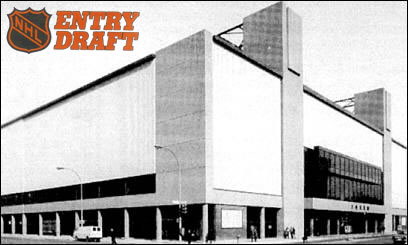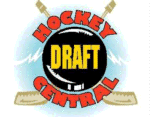|
|
| 1983 DRAFT QUICK FACTS |
DATE: JUNE 9, 1984

LOCATION: MONTREAL
FORUM |
| DRAFT HISTORY |
The sixth NHL Entry Draft was all about Mario Lemieux -- major junior hockey's
6-foot-4 superstar who was certainly head and shoulders above all other players
in his draft class.
In the months before the draft, it was clear that Lemieux would be the first
overall pick. At the end of the 1983-84 NHL regular season, the Pittsburgh
Penguins gained the right to select Lemieux by finishing last overall in the
league. Pittsburgh fans immediately began talking about the player they believed
would turn their franchise into a winner.
Although Lemieux would go on to make even the most skeptical Penguins fan's
wildest dreams come true, at the time of the 1984 draft, there were questions
about his attitude and whether he would ever be willing to play in Pittsburgh.
Attitude was a legitimate concern, because of Lemieux's pattern of behavior. He
had sat out the 1984 World Junior Championships because he didn't like Team
Canada head coach Dave King's treatment of French-Canadian players. He had also gone
on the record in his hometown of Montreal saying that he did not want to play
for the Montreal Canadiens because he felt it would be too much pressure. And in the days
before the draft, Lemieux and agent Gus Badali had made it clear that they were
not happy with the type of contract the Penguins were offering.
It all came to a head on draft day, when Lemieux's name was called by Penguins
general manager Eddie Johnston. Upset over the contract talks, Lemieux refused
to put on a Penguins sweater, although he said he'd be happy to play for the
team once he could sign an acceptable contract -- which finally happened 10 days
after the actual draft.
While Lemieux was the clear focus in 1984, there were other notable aspects to
this draft. First, it was the 22nd consecutive draft staged in Montreal, but it
was also the last to be held there before the league began phasing in a new
tradition of moving the draft to other NHL cities -- with Toronto going first in
1985. One reason the draft could outgrow its Montreal roots was because in 1984
the event drew its first national TV audience in Canada. The Canadian
Broadcasting Corp., producer of Hockey Night in Canada, decided to begin
televising the annual draft, which vaulted the once low-key process to a new
level of importance among fans. It would be years, however, before the draft
could also be seen by TV audiences in the U.S.
Also in 1984, the NHL recognized the growing influence of European prospects by
hiring a Finnish-based scouting service to rank eligible overseas players in
the same way that the NHL Central Scouting Bureau was ranking North American players
back home. For the first time in history, NHL scouts and general managers had a
list of ranked Europeans, and this new piece of the puzzle led to a record 40
players being drafted off European rosters, easily breaking the previous record
of 35. A 41st foreign player, who spent the 1983-84 season as an exchange
student at a Minnesota high school, was also drafted.
Perhaps the most important European chosen in 1984 -- and the most surprising --
was Czechoslovakian defenseman Petr Svoboda. Few in the NHL even knew that
Svoboda had already defected from his home country and was in Montreal. So
Canadiens GM Serge Savard stunned the draft audience when he not only announced
Svoboda as his first-round pick at No. 5 overall, but then proceeded to bring
the Czech junior star out to the draft floor. The unexpected appearance thrilled
the hometown fans who up until then had been focused on the question of whether
or not Lemieux would ever be happy in Pittsburgh.
While Montreal made headlines with the Svoboda pick, the Canadiens did something
far more significant in the third round by selecting goalie Patrick Roy.
Although Roy wasn't the highest-profile goaltender in the pool -- and was
actually the third selected after Craig Billington and Daryl Reaugh -- he would
go on to become one of the most brilliant picks in NHL draft history. Arguably
the greatest goaltender of all time, Roy led Montreal to two Stanley Cups -- not
bad for a 51st overall pick.
Trades were also a factor in the 1984 NHL Entry Draft. Although the
Penguins steadfastly refused to trade their No. 1 pick, several other teams were
willing to deal first-rounders. The most dramatic trade was Chicago's
draft-day move to get up to the No. 3 pick so the Black Hawks could take
Chicago's own Ed Olczyk, who played for the 1984 U.S.
Olympic team as a 17-year-old. In moving up to No. 3, Chicago also made a second
trade with New Jersey to ensure the Devils would not take Olczyk with the No. 2
pick. Chicago gave the Devils future considerations in exchange for the promise
that New Jersey would pass on Olczyk. Those future considerations were settled
10 days later when Chicago traded Don Dietrich, Rich Preston and its 1985
second-round pick (Eric Weinrich) to New Jersey in exchange for Bob MacMillan
and a 1985 fifth-round pick (Rick Herbert) on June 19, 1984. Although Olczyk wouldn't have the same effect on
the Black Hawks franchise that Lemieux would have in Pittsburgh, he was a
popular choice as the first hometown player selected by Chicago in Round 1.
On a less glorious note, 1984 marked the first time in draft history that a team
unintentionally erred by calling the name of an ineligible player. In fact,
there were two such errors. In the ninth round, Buffalo tried to choose Eric
Weinrich, who was too young to be selected, and in the 11th round, Philadelphia
tried to pick Czech defenseman Petr Rucka, who had already been selected in the
previous round by Calgary. |
| THE BASICS |
Eligible For Draft: All North American amateur players
born between January 1, 1964, and September 15, 1966, and all European
players born before September 15, 1966.
Draft
Order: Non-playoff teams had the first five picks and drafted in reverse order of their 1983-84 finish.
The 16 playoff teams then drafted in reverse order of their 1983-84 finish.
Irregularities: Buffalo
had to forfeit its ninth-round pick after calling the name of Eric Weinrich,
whose birthday fell after the cutoff date for draft eligibility.
Philadelphia had to forfeit its 11th-round pick after calling the name of Petr Rucka, who had already been drafted.
Rotation:
Pittsburgh, New Jersey, Los Angeles, Toronto, Hartford, Chicago, Detroit,
St. Louis, Winnipeg, Vancouver, Montreal, Calgary, Minnesota, N.Y. Rangers,
Quebec, Philadelphia, Washington, Buffalo, Boston, N.Y. Islanders, Edmonton
Total Rounds:
Twelve
Cost to Draft: The NHL paid a lump sum to the CMJHL to support
major junior hockey as a whole. The NHL teams also negotiated fees with
individual European teams for the release of European players.
Draft Rights: Team could offer
player contract at any time after draft, however, underage players would be
required to begin the 1984-85 season with their major-junior teams if they did
not make their NHL teams out of camp, and would only be available for
emergency recall. |
| DRAFT RECAP |
No. 1 pick: Mario Lemieux (by Pittsburgh)
Reached
NHL: 102 players (40.8 percent)
Won Stanley Cup: 20 players
(8 percent)
Most NHL Games:
Luc Robitaille (1,366 games)
Most
Playoff Games: Patrick Roy (247 games)
Highest Pick to Miss:
No. 13 (David Quinn)
Lowest Pick to Reach: No. 244 (Peter Loob)
Players Drafted:
250 (142 forwards, 88 defense, 20 goalies) |
|
|
Help support the rebuilding of HDC! |
HockeyDraftCentral.com is in the middle of rebuilding. You are
looking at a page that is not yet updated but is still part of the old site.
Find out how you can help make this an even better site by bidding on eBay
auctions.
• Learn More
|
|
SNAPSHOT '84 | | Total Selected: |
250 | | Forwards: |
142 | | Defense: |
88 | | Goaltenders: |
20 | | Major Junior: |
110 | | Tier II/Jr. B: |
16/9 | | College Players: |
23 | | High School: |
47 | | Midget: |
4 | | U.S. Junior B: |
1 |
| Canadian: |
145 |
| Euro-Canadian: |
2 | | USA Citizens: |
62 | | U.S.-Born: |
63 |
| European: |
41 |
| Reached NHL: |
102 |
| Stanley Cup: |
20 | | Hall of Fame: |
1 |
| All-Star Game: |
18 |
| Year-end All-Star: |
7 |
| Olympians: |
31 |
|
|

